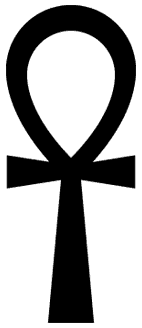Ankh
From Thelemapedia
The ankh (pronounced 'ahnk') is a cross with a loop at the top (also called a crux ansata), and was an important Egyptian symbol representing eternal life and the concept "to go". It is also called the "key of life" or the "key of the Nile." In numerous ancient drawings of Eyptians gods, they are often depicted holding an ankh, either by the end or by the loop.What it is a picture of remains a mystery to Egyptologists. A popular interpretation is that it represents a sandal strap, because it is believed that the Egyptian word for it and for "life" were the same: 'nḫ. Some have speculated that it represents a stylized womb. It is also possible that it symbolized the rising of the sun over the eastern horizon. Yet another interpretation is that of sexual intercourse, the key of life, and so another form of the rosy cross.
The ankh appears frequently in Egyptian tomb paintings and other art; it often appears at the fingertips of a god or goddess in images that represent the deities of the afterlife conferring the gift of life on the dead person's mummy. The ankh symbol was often carried by Egyptians as an amulet, either alone, or in connection with two other hieroglyphs that mean "strength" and "health." Mirrors were often made in the shape of an ankh.
For Aleister Crowley, it was but another symbol of the Great Work—attainment via the conjunction of opposites:
- The Tau and the circle together make one form of the Rosy Cross, the uniting of subject and object which is the Great Work, and which is symbolized sometimes as this cross and circle, sometimes as the Lingam-Yoni, sometimes as the Ankh or Crux Ansata, sometimes by the Spire and Nave of a church or temple, and sometimes as a marriage feast, mystic marriage, spiritual marriage, "chymical nuptials," and in a hundred other ways. Whatever the form chosen, it is the symbol of the Great Work. (Magick, Book 4).
For Crowley, the ankh was also a symbol of divinity, which is characterized by motion: "This is why the Ankh or 'Key of Life' is a sandal-strap, borne in the hand of every God as a mark of his Godhead: a God is one who goes", and, "The symbol of Godhead in Egypt was the Ankh, which is a sandal-strap, implying the Power to Go" (Magick Without Tears).
And like the rosy cross, the ankh is also closely associeted with Ra-Hoor-Khuit:
- "Glory unto the Lord of the Word Abrahadabra, and Glory unto Him that hath given us the Symbol of the Ankh, and of the Cross within the Circle!" ("Liber III vel Jugorum")
See also
References
- Ellison, Taylor. (2003). The Ancient Ankh, Symbol of Life (http://www.touregypt.net/featurestories/ankh.htm).
- Wikipedia. (2005). Ankh (http://en.wikipedia.org/wiki/Ankh). Retrieved on June 25, 2005.
- Crowley, Aleister. (1997). Magick: Book 4. 2nd ed. York Beach, Me. : S. Weiser.
- ____. (1982). Magick Without Tears. Phoenix, AZ : Falcon Press

![[Main Page]](http://www.thelemapedia.org/images/logo.gif)